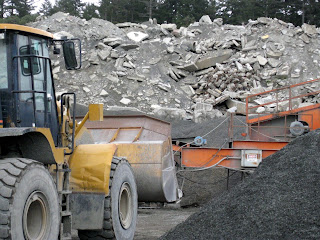Everyone was excited by the transformation that took place as each path was cleared of rocks, levelled then covered with gravel. Josh, Dave and Taylor worked very hard wheelbarrowing loads of gravel, levelling and compacting.
The finished Pergola area compared with the rough path in the foreground.
The Arbour. No more stumbling over rocks and into holes. And the gravel makes the right sound when I walk on it. However, it is not friendly to bare feet.
Arbour path and Pergola. It was in the plan the Gravel Bed rocks would be lighter in value than the paths to make it read further away and deeper than it is. Also, the different value keeps the 2 'rooms' separate.
I used the longest path-guide stick to mark out the edge of the path with blue tape. This is a path the lawn tractor uses to enter the back yard through the cedar gate.
Sammy Kent, the owner of Pacific Ecoscapes, arrived with his team and started the preparation work on the hard surface for the Pergola area.
Josh and Taylor prep the main path to my studio. I used the middle-sized path-guide stick to mark out its shape. It is a walking path 2 can walk along together and it can also accommodate a wheelbarrow.
Sammy worked with Josh's team advising on the best construction method for the landscape.
The log edges tie the studio beds to the log edges around the Hugel-kultur beds. They define the edge of the meadow areas and the add to the symmetry of the inviting approach to the Studio. They also help to make the Studio front door obvious.
The 2 main equipment items needed for the hard labour of moving and placing gravel are a wheelbarrow and a compactor.
It was decided to put a permeable cloth under the back path to the studio to restrict the growth of plants growing up through the gravel.
I had used the shortest path-guide stick to mark out this path. It is made for one person to walk along. It is my short route to the Studio when it is raining. Once the plants have matured it will barely be visible.
There was enough fabric to line the main path to the studio as well. With fabric down the gravel doesn't need to be as deep, only about 2 inches compared with the other paths that need over 3 inches of gravel to stop plants growing in it.




























































